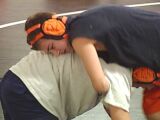 ANN ARBOR, Mich. New research from the University of Michigan shows patients who have recurrent shoulder dislocations may benefit from surgical reconstruction using cadaver bone and cartilage to essentially ‘sculpt' a new shoulder.
ANN ARBOR, Mich. New research from the University of Michigan shows patients who have recurrent shoulder dislocations may benefit from surgical reconstruction using cadaver bone and cartilage to essentially ‘sculpt' a new shoulder.
The shoulder is the most commonly dislocated joint in the human body, occurring most often in youth athletes, particularly wrestlers. For some patients, standard stability-restoring procedures are ineffective.
"We've been looking at defects of the humeral head, which is the ball part of the shoulder, and the effects of those [defects] on recurrent instability following surgical repair," says Jon Sekiya, M.D., surgeon and associate professor in the Department of Orthopaedic Surgery. "We really looked at this bio-mechanically and we've been able to show that certain lesion sizes are at greater risk [for repeated dislocation]."
The study showed that even small defects and small divots in the humeral head can cause biomechanical consequences which can affect stability. Because standard procedures meant to tighten the ligaments and repair the tissues responsible for stabilizing the joint do not address bone defects, a new technique was developed.
"The most common way to reconstruct or stabilize a shoulder joint is a soft tissue repair, which is repairing the capsule and ligaments that hold the joint in place and this is [usually] very successful," Sekiya says. "But in situations where there's missing bone ... the soft tissues see forces that are much higher than they can withstand and they fail."
Repeated dislocations affect quality of life
Brett Mann, a former wrestler, age 33 from Dexter, Mich., knows the effects of repeated shoulder dislocations and failed surgeries all too well.
"I started wrestling at four years old and pretty much every other sport I could get my hands on. I've always been athletic and active," Mann says. "My shoulder dislocates sometimes once or twice a night if I'm not wearing my sling. From all the dislocations, I've chipped away a lot of the bone and pieces of bone have broken off so it actually doesn't stay in the socket."
For patients like Mann, the pain can be excruciating and quality of life can be affected.
"I've had six previous surgeries and I haven't always followed the rules, but I'm seeing Dr. Sekiya for surgery number seven," he says. "If I'm not wearing my sling, I'll go to reach and grab for something and it will come out. Sometimes I can't get it back in so I have to go to the hospital. My main goal is for the pain to go away and just to be able to golf. All the other stuff I can forget about."
Sculpting a new shoulder joint
To sculpt the new joint, surgeons take cadaver cartilage and bone from both the cup part of the shoulder- the socket, called the glenoid, and the humeral head, which is the ball of the upper arm bone. They match the shape and size to the patient's joint and fix it to areas missing tissue and bone.
"We transfer and transplant the tissue from a cadaver to a human by matching it with X-rays to make sure the sizes are appropriate then in surgery we actually shape it to be the same shape and consistency as the patient and then secure it in there and let it heal," says Sekiya, who is also a team physician in the U-M Athletic Department. "We've been very successful at this. We've been able to stabilize shoulders that have been dislocating recurrently and have even failed one, two, sometimes three surgical procedures that did not address the bone and cartilage damage."
Who should get the surgery
Sekiya says anyone who has had repeated shoulder dislocation, or failed surgical attempts to repair the problem, should discuss the possibility of bone defects in their shoulder joint with their physician.
Sekiya practices at MedSport, the University of Michigan Health System's sports medicine clinic.
Source: University of Michigan Health System
Created December 11, 2009








